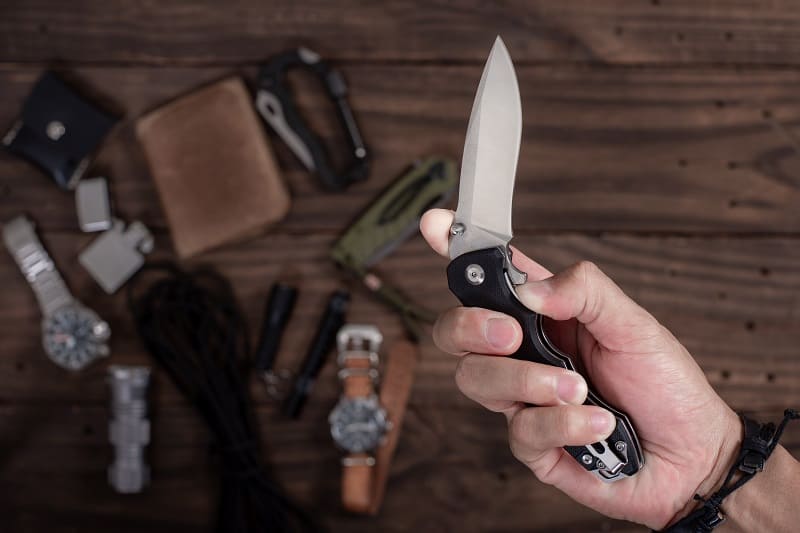Pocket knives are popular in today’s era of multitasking and readiness. Understanding a pocket knife and its functions can assist you whether you’re an outdoor enthusiast, a handyman, or someone who likes having a compact cutting instrument on hand.
This guide covers pocket knives’ history, designs, applications, and safety. Let’s explore the pocket knife!
What Is a Pocket Knife?
Pocket knives are small folding blades designed for pocket carry. It has one or more blades that fold neatly into the handle for easy storage. Pocket knives are popular among individuals who need a versatile cutting tool for daily tasks due to their small size and portability.
The History of Pocket Knives
The millennia-long history of pocket knives unfolds before us. It is a tale of diverse civilizations trying to create their own adapted tool.
Pocket knives have evolved over time, from the elaborate Roman folding knives to the medieval European peasant knives.
Evolution of Pocket Knife Designs

Pocket knives have changed to suit various needs. Let’s look at some of today’s popular pocket knife designs:
Slipjoint Pocketknives
Slipjoint pocket knives are the standard. A back spring lets the blade swivel open and close. Slipjoint knives include a primary blade for general cutting and auxiliary blades for specialized applications.
Lockback pocketknives
Lockback pocket knives, often called folding hunters, lock the blade when open. Hunters and outdoor enthusiasts like lockback knives for their safety and stability.
Linerlock Pocket Knives
Liner lock pocket knives use a handle liner to lock the blade open. This safety feature prevents inadvertent closing. Heavy-duty users like liner lock knives.
Multitool pocketknives
Multitool pocket knives have pliers, screwdrivers, saws, can openers, and folding knives. Outdoor enthusiasts, campers, and anybody who need a compact toolbox will love these multi-tools.
Uses of Pocket Knives

Pocket knives are versatile. Some frequent pocket knife uses:
Everyday Carry
Pocket knives are crucial EDC items. A pocket knife prepares you for daily cutting and slicing chores like opening packages and cutting zip ties.
Outdoor Activities
Campers, hikers, fishermen, and hunters need pocket knives. They can prepare meals, cut ropes, trim branches, clean fish, and more. A pocket knife will prepare you for outdoor challenges.
DIY/Home Improvement
A pocket knife can help with DIY projects or household repairs. A pocket knife can open paint cans, strip wire, cut drywall, and open resistant packaging.
Self-Defense
Pocket knives are mostly used for utility, but they can also be used for self-defense. Please note that self-defense pocket knife laws differ by jurisdiction. Before buying a pocket knife for self-defense, check local laws.
Hobbyist and collecting
Pocket knives are extremely popular with collectors. Some like pocket knives’ intricate designs, craftsmanship, and history. Pocket knife collecting and study can be an interesting pastime.
Safety Considerations for Pocket Knife Use

Pocket knives are useful, but safety should always come first. Safety tips:
Handle with Care: Hold the knife firmly and keep your fingertips away from the blade. Avoid cuts when opening and closing the knife.
Choose the Right Blade: Pocket knives have different blade shapes and sizes. Choose the right blade for the job to maximize productivity and reduce injuries.
Keep the Knife Sharp: A dull blade requires more force to cut, increasing the risk of accidents. Keep your pocket knife sharp.
Store Properly: To minimize inadvertent exposure and blade damage, store your pocket knife in a sheath, bag, or pocket clip while not in use. For safety, always close it.
Know the Laws: Know your local pocket knife laws. Blade length and concealment limitations vary by jurisdiction.
Questions (FAQs)
Are pocket knives legal?
Pocket knives are illegal in some places. Research your state’s pocket knife, blade length, and concealed carry legislation.
How can I sharpen my pocket knife?
Pocket knives operate best when maintained and sharpened. Clean and dry the blade and handle before storing. A sharpening stone, honing rod, or professional service can sharpen the blade.
What pocket knife should I buy?
The correct pocket knife depends on use, tastes, and local legislation. Consider blade length, handle material, locking mechanism, pocket clip, and built-in tools.
Read reviews, compare brands, and try out the knife to be sure it fits your needs.
How can I prevent blade rust?
Stainless steel blades prevent corrosion. After usage, clean and dry the knife to avoid rust and prolong its life. If you reside in a humid area or have a carbon steel blade that rusts easily, lubricate the blade occasionally.
Should I sharpen a pocket knife myself or hire a pro?
A6: The correct equipment and knowledge can sharpen a pocket knife. DIY sharpening systems, whetstones, and rods are available if you’re comfortable. For optimum results and blade integrity, get expert aid if you’re unsure or inexperienced.
Conclusion
Finally, a pocket knife is convenient, useful, and prepared for many circumstances. A pocket knife is useful for outdoor enthusiasts, DIYers, and anyone who wants a compact, reliable cutting tool.
You can choose the right pocket knife by considering its designs, usage, and safety concerns. Safety, local laws, and pocket knife maintenance are essential for best performance and longevity.
